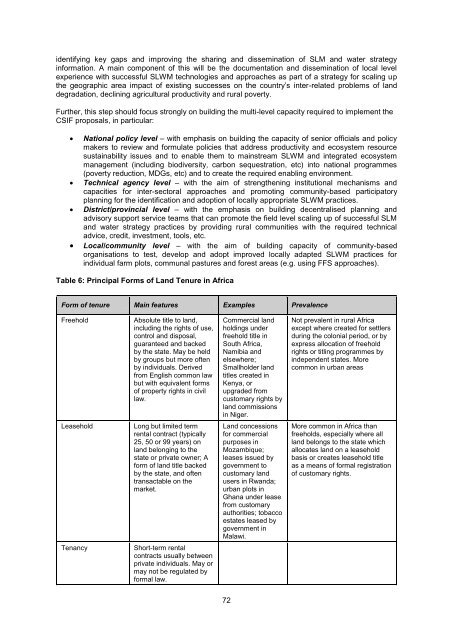The CAADP Pillar I Framework
The CAADP Pillar I Framework
The CAADP Pillar I Framework
- No tags were found...
You also want an ePaper? Increase the reach of your titles
YUMPU automatically turns print PDFs into web optimized ePapers that Google loves.
identifying key gaps and improving the sharing and dissemination of SLM and water strategyinformation. A main component of this will be the documentation and dissemination of local levelexperience with successful SLWM technologies and approaches as part of a strategy for scaling upthe geographic area impact of existing successes on the country‘s inter-related problems of landdegradation, declining agricultural productivity and rural poverty.Further, this step should focus strongly on building the multi-level capacity required to implement theCSIF proposals, in particular:National policy level – with emphasis on building the capacity of senior officials and policymakers to review and formulate policies that address productivity and ecosystem resourcesustainability issues and to enable them to mainstream SLWM and integrated ecosystemmanagement (including biodiversity, carbon sequestration, etc) into national programmes(poverty reduction, MDGs, etc) and to create the required enabling environment.Technical agency level – with the aim of strengthening institutional mechanisms andcapacities for inter-sectoral approaches and promoting community-based participatoryplanning for the identification and adoption of locally appropriate SLWM practices.District/provincial level – with the emphasis on building decentralised planning andadvisory support service teams that can promote the field level scaling up of successful SLMand water strategy practices by providing rural communities with the required technicaladvice, credit, investment, tools, etc.Local/community level – with the aim of building capacity of community-basedorganisations to test, develop and adopt improved locally adapted SLWM practices forindividual farm plots, communal pastures and forest areas (e.g. using FFS approaches).Table 6: Principal Forms of Land Tenure in AfricaForm of tenure Main features Examples PrevalenceFreeholdAbsolute title to land,including the rights of use,control and disposal,guaranteed and backedby the state. May be heldby groups but more oftenby individuals. Derivedfrom English common lawbut with equivalent formsof property rights in civillaw.Commercial landholdings underfreehold title inSouth Africa,Namibia andelsewhere;Smallholder landtitles created inKenya, orupgraded fromcustomary rights byland commissionsin Niger.Not prevalent in rural Africaexcept where created for settlersduring the colonial period, or byexpress allocation of freeholdrights or titling programmes byindependent states. Morecommon in urban areasLeaseholdLong but limited termrental contract (typically25, 50 or 99 years) onland belonging to thestate or private owner; Aform of land title backedby the state, and oftentransactable on themarket.Land concessionsfor commercialpurposes inMozambique;leases issued bygovernment tocustomary landusers in Rwanda;urban plots inGhana under leasefrom customaryauthorities; tobaccoestates leased bygovernment inMalawi.More common in Africa thanfreeholds, especially where allland belongs to the state whichallocates land on a leaseholdbasis or creates leasehold titleas a means of formal registrationof customary rights.TenancyShort-term rentalcontracts usually betweenprivate individuals. May ormay not be regulated byformal law.72
















